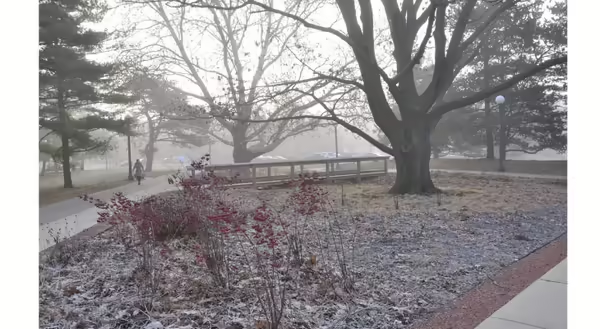
While this winter has brought little ice and snow cover, this past weekend’s winter weather put a coating of ice on most smooth surfaces. Gardeners, businesses, parks and others with landscaping near walkways must apply deicing salts for safety, but these products can harm plant life.
Deicing salts
Sodium chloride is the most common and cheapest deicing product available. It’s the easiest to find and the most widely used but can have some of the biggest negative effects on plants and, through its corrosive properties, hardscaping, not to mention other environmental concerns. There are alternative deicing products available, but according to Sarah Zack, Extension Pollution Prevention Specialist with Illinois-Indiana Sea Grant, “the alternatives also come with their own sets of issues.”
For resources on how to deice in an environmentally-friendly way, check out the Salt Smart Collaborative and Wisconsin Salt Wise.
Salt tolerant plants
One solution to this dilemma lies in the plants we select for problem areas in the landscape. With such a diversity of plant life, which has evolved in even the harshest environments on this planet, as well as the ever-increasing availability of new landscape plants, there has to be a perfect plant for that salty sidewalk or unforgiving roadside.
However, the science out there on landscape plant performance with exposure to deicing products is sparse. A number of sources recommend plants, based on professional experience or observation, but the hard science behind these selections is certainly lacking. When you attempt to find Illinois-specific resources, there is little research to draw upon.
Red Oak Rain Garden (RORG)
One project on the University of Illinois campus that has considered the use of deicing products in its design is the Red Oak Rain Garden (RORG). RORG is an amazing project that exemplifies the use of native plants in landscaping. In this 11,000 square foot garden space, there are over 13,000 native plants packed into both sun and shade locations around the garden’s namesake, a large majestic Red Oak.
Across the rain garden, 53 native species are represented, making it an excellent showcase of native plants in landscaping. However, the garden is surrounded by sidewalks and parking lots filled with passing students and the bustle of campus, making deicing a necessity this time of year.
RORG addresses salt damage to plants
RORG Director Eliana Brown led a design team that found ways to minimize salt’s impact to plants.
“Around the main garden, we specified a barrier of crushed granite that helps capture salt. And we set up plant health monitoring that helps us know if we need to make any changes. But, plant selection is our key strategy and we want to know more about how certain native plants handle these conditions,” notes Brown.
Recently, RORG Landscape Designer, Layne Knoche, added a new special selection of plants designed to withstand the stress of salt and heavy traffic near the busy parking lot adjacent to the rain garden.
“We were looking for tough landscape plants that were noted to have some salt tolerance, but also were simply beautiful,” reflects Knoche.
The location, next to the main rain garden, has the same high-traffic sidewalks that shed salt-laden runoff. The team decided to not add the granite barrier in this expanded area to really give the plants a test. Thus, plants needed to be tough competitors to persist.
“As you look into the research, there just isn’t much supporting data for salt tolerance in landscape plants. While our planting is not a formal experiment, we’ll monitor progress and invite the public to enjoy right along with the RORG team as we watch the plants perform in coming years.”
Brown, who is an Extension Water Quality Specialist with Illinois-Indiana Sea Grant, and her staff member Knoche have a special interest in finding salt tolerant native plants as they expand RORG’s resources for home gardeners to incorporate sustainable landscaping practices that support clean water. Further, they are both avid gardeners themselves.
“I plan to install a modified version of Layne’s design in the right of way near the street in front of my home in Champaign,” notes Brown.
Connect with RORG
If you are interested in checking out the tough plants at RORG, the project is located on campus between Allen Hall and McKinley Health Center. The expansion planting was added in 2021 to a small bed along the south border of the parking lot adjacent to the rain garden, between the parking lot and a sidewalk. This coming growing season will be a great time to watch these plants mature and see how they fare after their first winter.
Stay tuned to the RORG website for more information and events in the garden. Throughout the year there are multiple opportunities to connect with the team out in the garden and learn more about the amazing plants at RORG.
Photo Credit: Eliana Brown, Illinois Extension/Illinois-Indiana Sea Grant